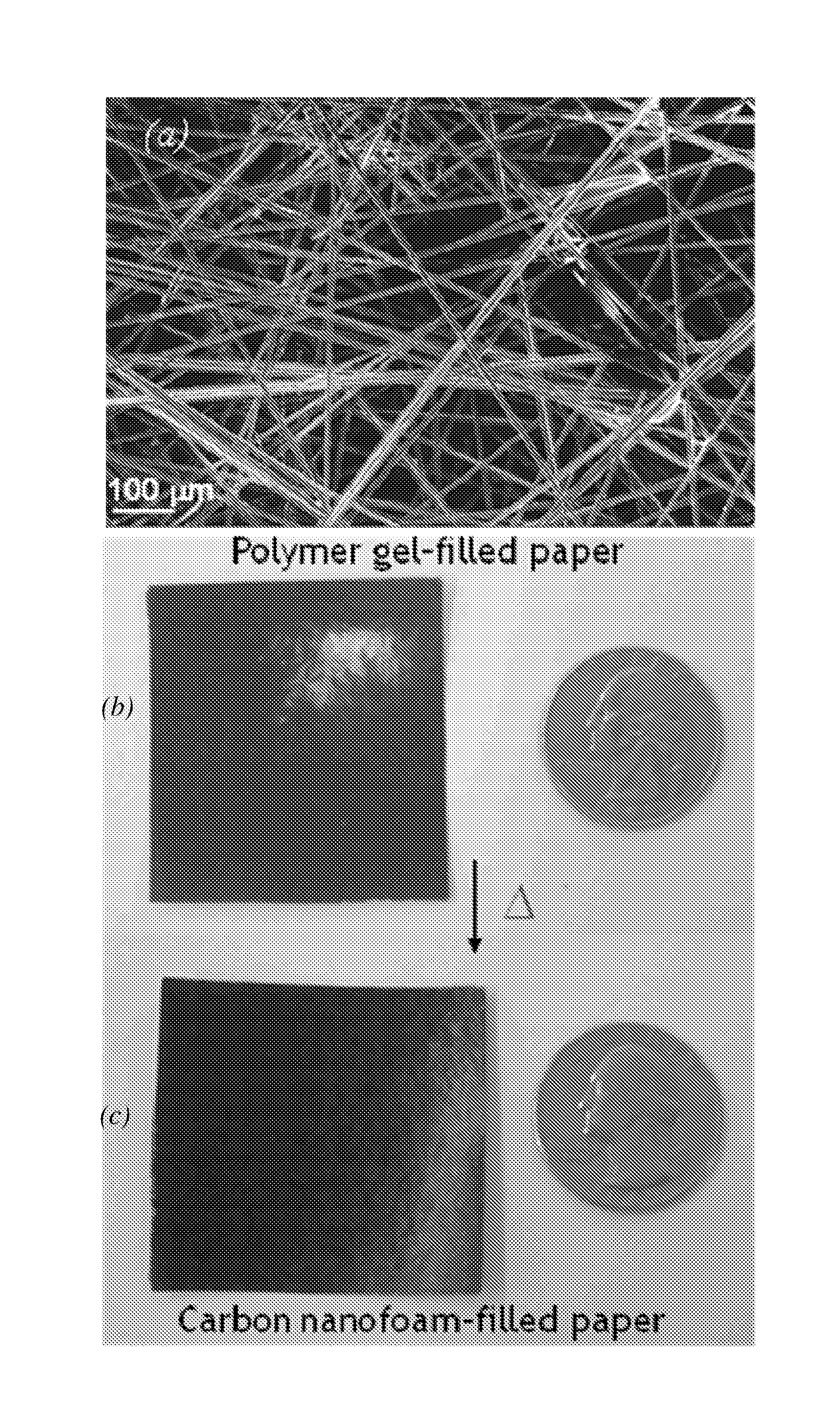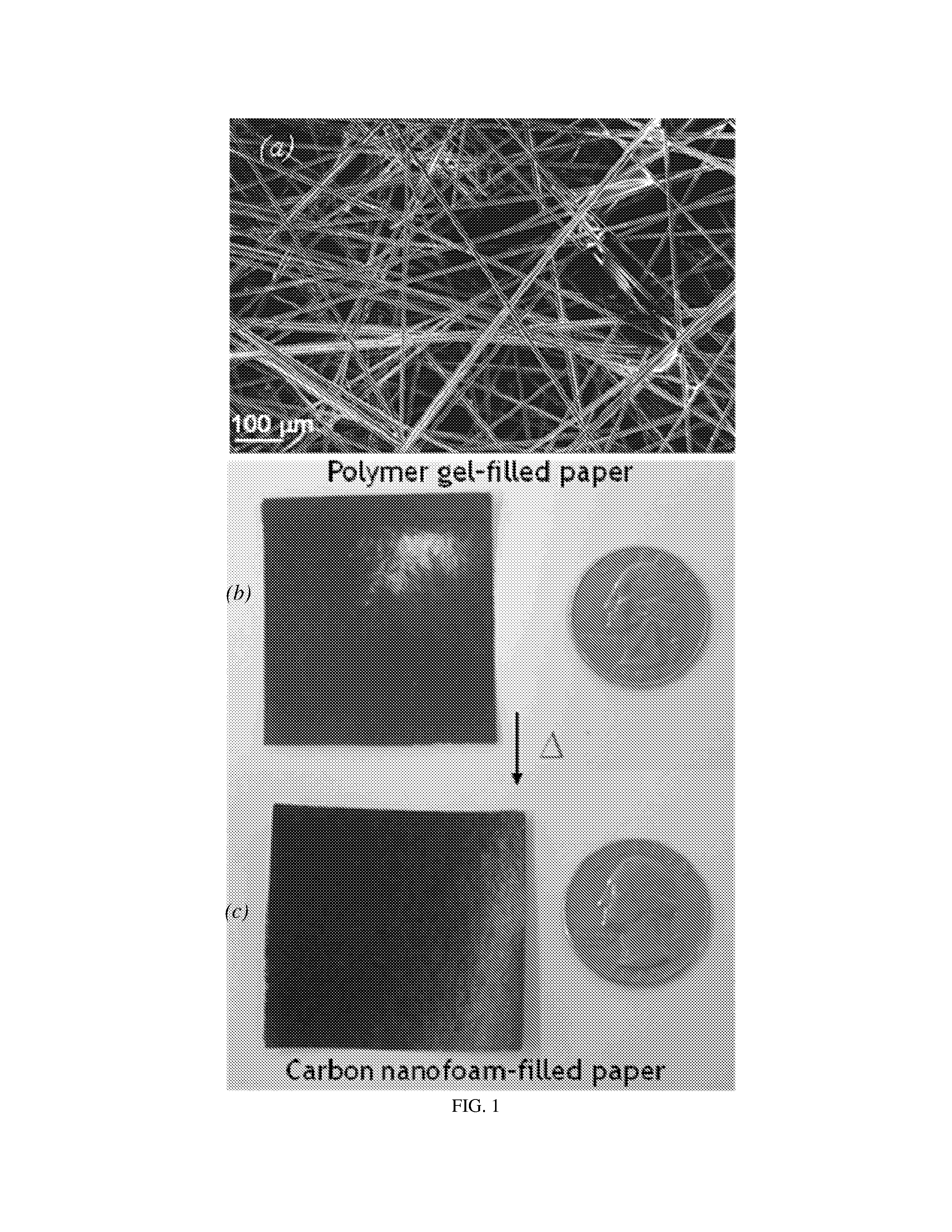Macroporous Carbon Nanofoam Composites
a carbon nanofoam and composite technology, applied in the field of macroroporous carbon nanofoam composites, can solve the problems of increasing the cost of synthetic and time-consuming, incomplete volume filling of interfiber voids, and reducing the uniformity of fluid uptake of carbon fibers, so as to reduce the hydrophobicity of carbon fibers and enhance the uniform uptake
- Summary
- Abstract
- Description
- Claims
- Application Information
AI Technical Summary
Benefits of technology
Problems solved by technology
Method used
Image
Examples
example 1
[0060]Low-density RF polymers are deposited on carbon fiber papers by the following technique. All samples were prepared from a resorcinol-to-formaldehyde (R / F) ratio of 1:2 and a R / C ratio of at least 1500:1 All reagents were purchased from Aldrich, and were used without further purification. Glass microscope slides purchased from Fisher Chemicals were cut to 2.75 cm×2.5 cm dimensions and degreased with acetone. Toray carbon fiber papers (TGP-050, density ˜0.4 g cm−3, 110-μm thick) and Lydall Technimat® carbon fiber papers (6100-050, density ˜0.2 g cm−3, 384-μm thick) were cut in 2.5 cm×1.5 cm strips and plasma etched (30 W) in the presence of moist air (0.4-0.8 torr) for 30 min. Carbon fiber paper is hydrophobic because of its nonpolar carbon bonds; plasma etching oxidizes the carbon fiber surfaces and permits the aqueous RF solution to fully infiltrate the paper. The presence of water vapor during plasma etching further increases the hydrophilic properties of the fiber paper.
[006...
example 2
[0073]Carbon nanofoams with pore sizes in the 10-50-nm range were prepared using the method previously described. 20 g of resorcinol, 29.4 g of formaldehyde, 12.3 g of H2O, 0.0384 g of Na2CO3 were combined and stirred for 30 minutes. The resulting mixture was allowed to stand at room temperature for 2.5 hours. The resulting RF sol was then infiltrated into the carbon fiber-paper, in accordance with the method of Example 1 and 2. The RF-impregnated papers were then packaged and placed in a table-top pressure cooker at 90° C. for at least 9 h to form the RF-polymer nanofoam paper having pore sizes in the range of from about 10 nm to about 50 nm.
example 3
[0074]Carbon nanofoams with pore sizes in the range of 500 to 1000 nm were prepared using the method previously described in Examples 1 and 2. Resorcinol (7.0932 g), 10.4842 g of formaldehyde (37%), 9.8589 g of H2O, and 0.0045 g of sodium carbonate were stirred together for about 30 min. The resulting solution was allowed to stand at room temperature for about 5 h. The resorcinol-formaldehyde (RF) sol was then infiltrated into carbon fiber-paper by the method described in Example 1. The resulting RF-nanofoam papers were allowed to sit at room temperature for 6 days. The RF-nanofoam papers were then heated at 90° C. in a table-top pressure cooker for 12 h to form the final RF-nanofoam paper.
[0075]FIG. 1 shows (a) scanning electron micrograph of 0.2 g cm−3 carbon fiber paper (Lydall Filtration / Separation, Inc.). Photographs of carbon-fiber-supported RF foam before (b) and after (c) pyrolysis at 1000° C. in flowing argon to form carbon-fiber-supported carbon nanofoam. Note that the shi...
PUM
| Property | Measurement | Unit |
|---|---|---|
| thickness | aaaaa | aaaaa |
| size | aaaaa | aaaaa |
| electronic conductivity | aaaaa | aaaaa |
Abstract
Description
Claims
Application Information
 Login to View More
Login to View More - R&D
- Intellectual Property
- Life Sciences
- Materials
- Tech Scout
- Unparalleled Data Quality
- Higher Quality Content
- 60% Fewer Hallucinations
Browse by: Latest US Patents, China's latest patents, Technical Efficacy Thesaurus, Application Domain, Technology Topic, Popular Technical Reports.
© 2025 PatSnap. All rights reserved.Legal|Privacy policy|Modern Slavery Act Transparency Statement|Sitemap|About US| Contact US: help@patsnap.com



